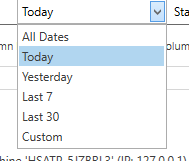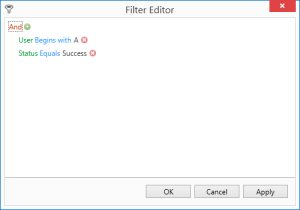Execution Events Table
Overview
The Execution Events table supplies comprehensive information with reference to all executed events, including the running of workflows and tasks as well as the activation of triggers. This report is useful for gathering runtime information, such as which workflow or task ran, which condition object triggered its execution, when execution started/ended, whether it ran successfully or failed and total runtime duration (among others). This report supports exporting to multiple document types, column filtering, data grouping, sorting, filtering and more.
For complete instructions on how to use table reports, see Using Table Reports.
Data sources
The Execution Events report displays data in a two-dimensional table. The bound data is arranged in columns and rows. Grid columns correspond to data fields in a data source, rows represent data records. The table below lists the available data sources along with a description.
| Column | Description |
|---|---|
| Event ID | The unique identifier of the event that took place. |
| Construct ID | The unique identifier representing an object and all of its settings and properties. |
| Name | The user defined name of the object that ran. |
| Type | The type of object that ran (that is, Workflow, Task, or Process). |
| Path | The complete path to the repository location of the object that ran. |
| Start | The date/time when execution started. |
| Executed On | The agent where execution of the object took place. If the execution type is a workflow, this field is left blank. |
| Result | The result of the execution (that is, Running, Success, Failed, or Aborted). |
| Result Text | A textual description of the execution result. |
| User | The user that manually ran the object (if the object was manually started). If the object started automatically based on a trigger, this field is left blank. |
| Transaction ID | The unique identifier referencing the atomic transaction that took place which generated the log record. An atomic transaction is an inseparable series of actions or operations that must either all occur, or nothing occurs. |
| Workflow Instance ID | The unique identifier of the workflow instance that ran. |
| Instance ID | The unique identifier of the object instance that ran. Each instance of an object that runs during workflow execution is assigned an instance ID. This provides a way to distinguish each execution of an object, even if the same object is run simultaneously. |
Report filtering
Filter by predefined date range
Select the predefined date range box located on the filter bar, and then select the desired range (default is Today).
Filter by custom date range
In the Starting or Ending box, select the down arrow to display the calendar/time controls to set the date and time.
Filter by columns
The Columns ![]() icon allows you to filter the columns to be included in
the report. To filter by columns, select the Columns
button, and then select/deselect the desired columns.
icon allows you to filter the columns to be included in
the report. To filter by columns, select the Columns
button, and then select/deselect the desired columns.
Filter by column data
To filter the data in a column: over your mouse over the column until a filter icon appears, and the Filter button allows you to filter the data that appears for a certain column.
-
Hover your pointer over a column header, and then select the Filter icon that appears.

-
Select the column data to include in the report from the list.
Advanced filtering
The Filter Editor allows you to build complex filter criteria with an unlimited number of filter conditions combined by logical operators. To open the Filter Editor, right-click any column header, and then select Filter Editor. The Filter Editor displays filter criteria as a tree structure, where nodes represent simple filter conditions. If the filter criteria consists of multiple filter conditions, the Filter Editor contains multiple nodes linked by logical operators.

